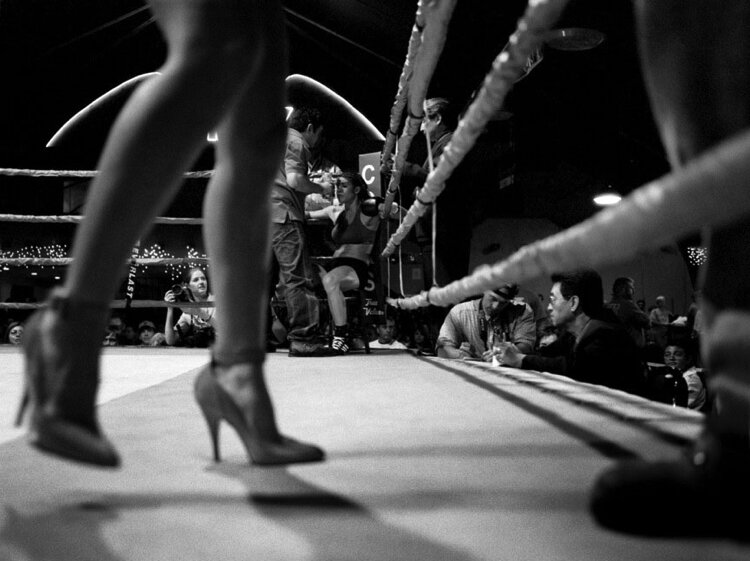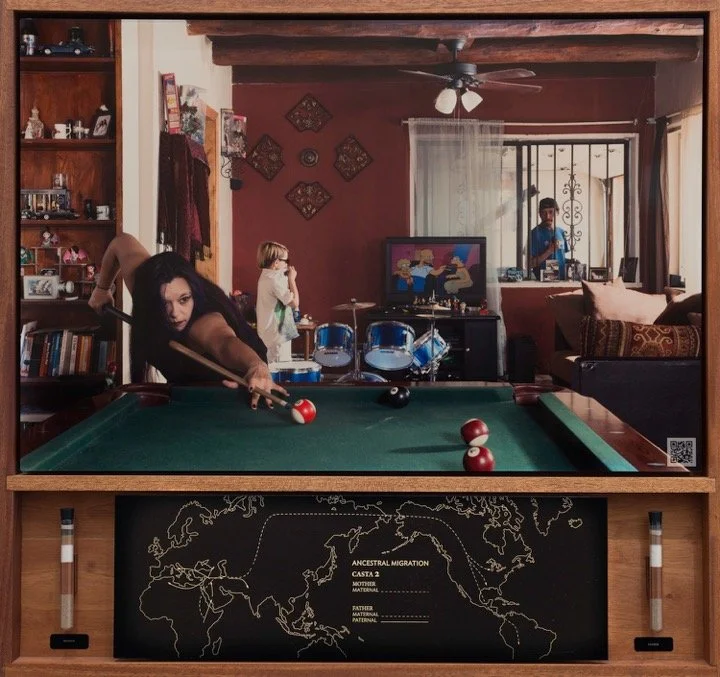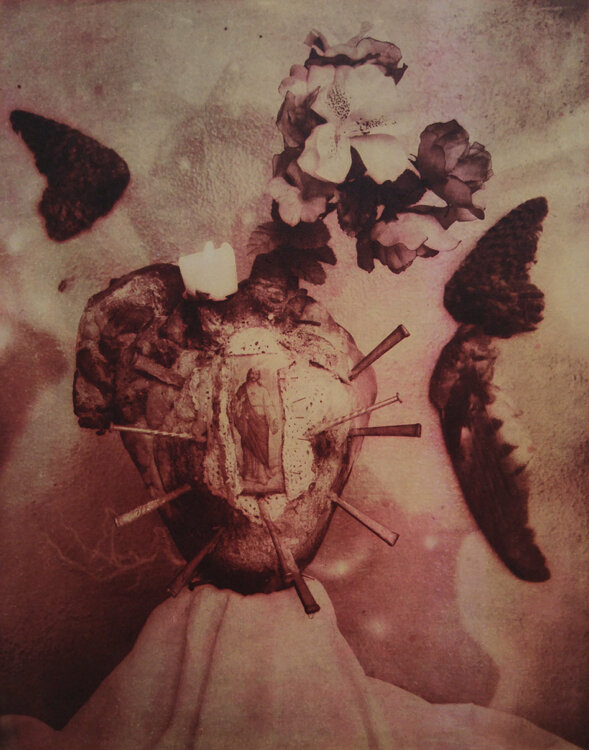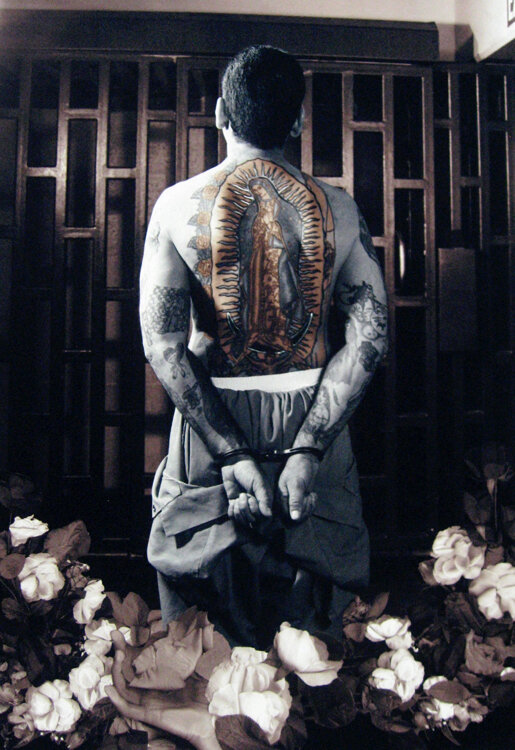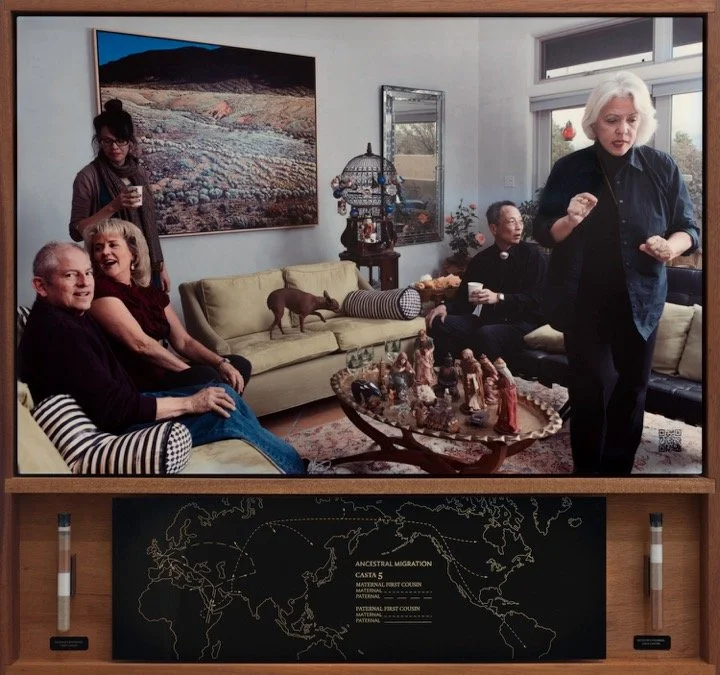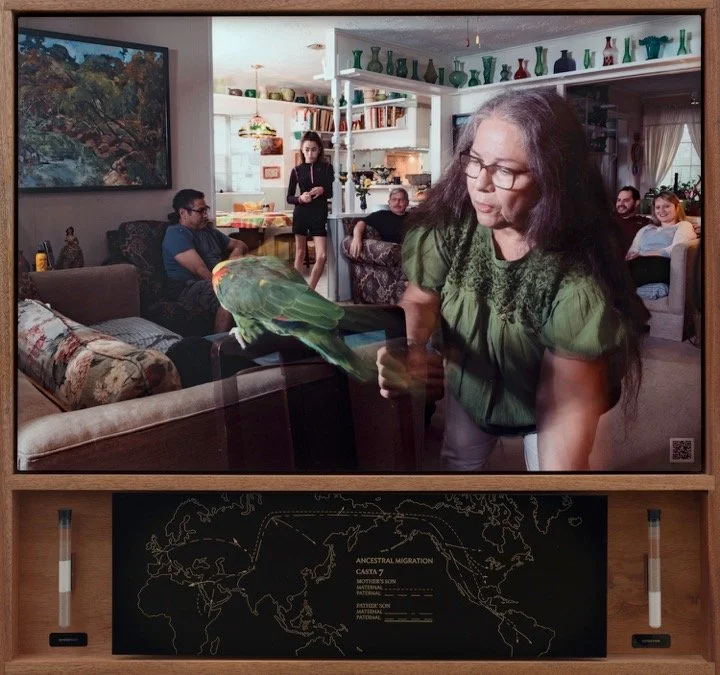DELILAH MONTOYA
Delilah Montoya (b. 1955, Ft Worth, Texas) was born in Texas to a Latina mother and an Anglo father. Her mother raised her in Nebraska until she relocated to New Mexico to attend college. She studied at the University of New Mexico where she earned her BA, MA, and MFA in Photography. While continuing to practice as a studio artist, she remained in academia where she has taught at the University of New Mexico, California State University, and the Institute of American Indian Arts. Montoya currently was a professor of Photography at the University of Houston in Texas.
New Mexico held ancestral roots that nourished her exploration of her Chicana identity. Montoya’s photography conceptually delves into the experience of the Southwest people that is the mix of Native American, Aztec Mexican, and Spanish lineage. These cultures offer rich historical traditions and folklore imagery based in spiritual and religious practices. Montoya visually explores this iconography to discuss and confront outsider assumptions on stereotypes and the “documentary gaze” towards the Mesoamerican community.
She uses traditional photographic techniques, mixed media, composites, printmaking and sculptural aspects to her work. New and mixed mediums allow her to continue to push boundaries and make conceptually challenging work. Her installations are narratives that involve not only the participation of the viewers cultural, historical, and spiritual knowledge but also their senses.
Montoya’s photographic work is celebrated within the Latino community as well as internationally. She has shown extensively in solo and group exhibitions throughout the world. Her work can be found in private and public collections as the Smithsonian American Art Museum, Los Angeles County Museum of Art, New Mexico Museum of Art, Mexican Museum, The Bronx Museum of the Arts, and the Museum of Fine Arts Houston.
Women Boxers: The New Warriors, an exhibition and book project, portrays professional female boxers as malcriadas. Funded in part by the University of Houston Small Grants Program and the Cultural Arts Council of Houston and Harris County, this work was exhibited during FotoFest 2006 at Project Row House and later at the McKinney Avenue Contemporary in Dallas, Texas. Dee Mitchell wrote a review for Art in America. Three prints from the series were purchased by the Sheldon Museum of Art for their permanent collection and were published in Encounters: Photographs from the Sheldon Museum of Art, University of Nebraska Press, 2013. Two prints, "Terri 'Lil Loca' Lynn Cruz" and "Pink" were selected for the traveling exhibit, "Infinite Mirror: Images of American Identity," produced by Artrain Inc. The Museum of Fine Arts Houston acquired the print, Audrey in her Corner, for their photography collection. A selection of photographs from the series, were featured in the exhibition, Body Armor, at MOMA’s PS1 in New York. A catalogue was published.
By crossing the ropes and getting into the ring, these professional athletes enter into the bastions of manliness to confront a brutal sport. Many, in fact, are appalled by the violent sport of boxing and believe it should be banned. But these women, determined to box, turn their backs on these opinions. Title IX of the Civil Rights Act and the feminist movement gave them the right, and they have taken it willingly. Female boxers fight because they can – they are professionally trained, and the boxing rules are now modified to allow women athletes to participate in this sanctioned combat.
Work from this series is currently on view in the exhibition, Strike Fast, Dance Lightly: Artists on Boxing at the Norton Museum of Art through March 9, 2025
Contemporary Casta Portraiture: Nuestra “Calidad” is an ethnographic art project that examines the ethnic roots of Colonial Heritage Families by photographing genre portraits and DNA testing the descendants living in Houston and Albuquerque. The project builds on the paradigm that colonial families of the “New World” evolved from a global community. The nuances woven into the topic are identity, colonial power struggles, family history, the optic-unconscious, and biogeographic ethnography and how these experiences are expressed in our contemporary lives and culture.
Following the 1825-Mexican Revolution, Mexico adopted a persona centered on mixed-race/ mestizo-identity. Mexican leaders hoped to unify the populace and foster national pride, the impact of this movement still resonates, as Mexicans and Central Americans identify as mestizo. By contrast, only 6.9% of Americans identified as multiracial. This is indicative of a widely held black- and-white perspective in the United States. It is this site of contestation, myth, and erased history where I locate the series Contemporary Casta Portraiture: Nuestra "Calidad."
Work from this series is currently on view in the exhibition, Contemporary Casta Portraiture: Nuestra “Calidad” at the National Museum of Mexican Art, through March 16, 2025
This work was originally produced for an installation at the Musée de Beaux-Arts Denys-Puech in Rodez, France, where the basilica in the central plaza hosted a 17th century Mexican easel painting of the Guadalupe. Since the community was familiar with the Guadalupe as a religious relic, Montoya aimed to reintroduce this image as a cultural icon that would demonstrate the Chicano vernacular. The intent was to bring back to Europe the Guadalupe as a container of the underpinnings of colonial dark side that foregrounds captivity, oppression, and servitude.
In the biography excerpt from Women Boxers: The New Warriors, Ondine Chavoya writes that, "This duality of saints and sinners--and the associated themes of life, death, and salvation--is also powerfully depicted in La Guadalupana (1998)… La Guadalupana is a 15 ½ -foot photomural. Shot with a large-format camera, the monumental image features a man faced away from the viewer, standing in front of metal bars, and posed with his hands behind his back in handcuffs. Emblazoned on his back is an elaborate and brilliant tattoo of La Virgen de Guadalupe. The image effectively channels the sacred and the profane and transforms the physical space of a prison cell into a sacred space and the body of the inmate into an ofrenda or altar. The memorializing function of the installation becomes all the more palpable when you learn that the person portrayed, Félix Martinez, was killed in his Albuquerque jail cell shortly after the photograph was taken. In this instance, the paired relationship of saint and sinner has the capacity to transform the viewer before the image into the penitent.”
Work from this series is currently on view in the exhibition, Between the Lines: Prison Art & Advocacy at the Museum of International Folk Art, through September 2, 2025
This collection of collotypes portrays Albuquerque’s Chicano Community. The series explores the manifestation of the Sacred Heart as a cultural icon that is embedded in the religious fabric of Chicano culture. Based on Montoya’s research and her Mestiza perspective, it is concluded that this Baroque religious symbol expresses shared cultural religious patterns that connote a syncretic relationship between European Catholicism and Aztec philosophy. The Baroque Sacred Heart in the Americas is an icon that resulted from an encounter. It is not purely Indian in content and never completely European in its form. Rather, it is a hybrid of two diverse cultures that clashed and bonded at a particular historic moment and created the foundation for religious syncretism.
This visual investigation of a cultural icon moves away from the traditional “objective” approach to reveal the hand of the photographer in relation to the community that was being depicted. In representing the Sagrado Corazón, the community was invited to collaborate with Montoya in the realization of the project. This collaborative project documented the manifestation of the heart as a cultural icon within the participating community. The alliance resulted in a magnificent display of creative interdependence that validates the Sagrado Corazón as an integral part of the Chicano collective conscience.

